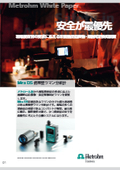[Raman Spectrometer Technical Documentation] Raman Spectroscopy - Inspecting Contents Through Containers
The new Raman spectroscopy technology can identify powdered samples inside white plastic containers or paper envelopes and measure active ingredients within tablet coating layers.
Raman spectroscopy is an established molecular spectroscopic technique for non-invasive and non-destructive chemical analysis. It is used primarily for the identification of organic materials such as carbon nanomaterials, regulated substances, hazardous chemicals, pharmaceutical raw materials, gemstones and minerals, affected tissues, pigments, and paintings. The portable Raman spectrometer STRam from B&W Tek is portable and equipped with software containing a spectral library, allowing it to provide identification results in under one minute.
basic information
PDF Page 6 《Free Download Available》
Price range
Delivery Time
Model number/Brand name
[Technical Data] Raman Spectroscopy - Sample Measurement Through Containers
Applications/Examples of results
Many solid chemical substances are often contained in white plastic containers made of polyethylene with titanium dioxide. This filler material scatters light, making the plastic appear opaque. Due to strong scattering, laser light cannot be focused inside such containers, making the use of conventional Raman measurements difficult. By using the STRaman Raman spectrometer, both the 785 nm excitation laser and the Raman scattered light can penetrate the walls of the plastic container through a diffuse scattering mechanism, allowing for a large effective sampling depth that enables the investigation and identification of such substances. Unknown samples are encountered in envelopes and packages by postal services, customs, border patrol, and law enforcement agencies. For initial screening, it is preferable to identify the contents without opening the packaging, minimizing exposure and unsealing of the package. Paper is primarily made of cellulose fibers that strongly scatter light. The Raman spectra of paper products, such as Manila envelopes, often exhibit strong fluorescence that contributes to a high background and frequently overwhelms the Raman spectra. Using the STRaman Raman spectrometer, D-(+) glucose can be easily identified through a Manila envelope.
Related Videos
catalog(16)
Download All Catalogs





Recommended products
Distributors
Metrom AG, based in Herisau, Switzerland, is a leading company specializing in ion analysis with over 70 years of history. It provides products and services in more than 140 countries worldwide. Based on Swiss technology developed over many years, the equipment comes with a 3-year warranty.





























































